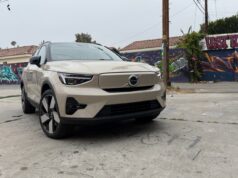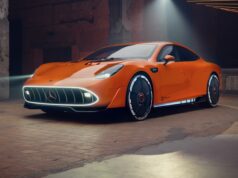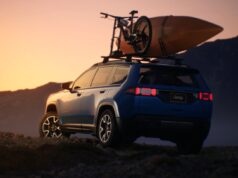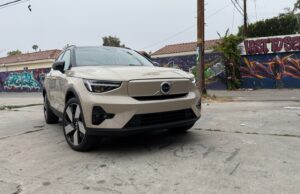
Volkswagen has finally unveiled its new four door coupe (Passat CC) which is based off the Passat sedan.
When the new Passat CC goes on sale in the US late this year it will be powered by two engines, a 2.0L TSI engine that puts out 197 horsepower and a 3.6L FSI V6 engine that puts out 276 horsepower. The 3.6L V6 comes with VW’s 4MOTION all-wheel drive standard.
Expect more details as well as final pricing for the Passat CC later this year.
Related Stories:
2009 Volkswagen Tiguan Will Start at $22,490
It’s Official: The US is Not Going to Get the Upcoming VW Scirocco!
PRESS RELEASE:
North American International Auto Show: World premiere of the first four-door coupé from Volkswagen
The Passat CC unifies sports car dynamics and sedan comfort First car in the world with Lane Assist lane keeping system Dynamic Drive Control electronic chassis system is standard starting at 170 PS High-class engines deliver 140 PS to 300 PS
Wolfsburg / Detroit, January 2008. Volkswagen is opening the year 2008 with the world premiere of the Passat CC. Its identifying characteristics: coupé design, yet with four doors; impressive comfort, yet pure dynamics; sporty interior, yet space without compromises. The interplay of these contrasts has resulted in a car whose concept and design set a new course beyond the mainstream. At the same time, the Passat CC is a progressive technological platform with high-class engines (103 kW / 140 PS to 220 kW / 300 PS) and innovative assistance and driving dynamics systems. These include world firsts in the “Lane Assist” lane keeping system and the “Dynamic Drive Control” electronic chassis control system. No less innovative: the “Park Assist” parking assistant and “ACC Automatic Distance Control” with stopping distance reducing “Front Assist”.
“Lane Assist”: This active lane keeping system on the Passat CC is unique worldwide in this vehicle class. It automatically countersteers as soon as the Passat CC leaves its lane unintentionally; a genuine gain in convenience and safety. About 14 percent of all accidents involving injuries are caused by the vehicle leaving its driving lane. “Lane Assist” will contribute to reducing this accident rate. By the way, if the driver sets the turn signal to intentionally change lanes, “Lane Assist” does not intervene.
“Dynamic Drive Control”: The car’s new “Dynamic Drive Control” (DDC) chassis control system combines the sportiness of a coupé and the comfort of a top sedan in one car. In parallel to tuning of the suspension’s damping characteristic, the power steering system is controlled too. “DDC” offers the three programs “Normal”, “Sport” and “Comfort”. Decisive here is the fact that Dynamic Drive Control improves comfort and dynamic properties in the “Normal” mode too – and therefore full-time. In certain markets, “DDC” is on-board as standard equipment on all versions starting at 125 kW / 170 PS.
“Park Assist”: Another high-end technology is the “Park Assist” parking assistance system. It automatically guides the Passat CC into a parking space at the push of a button. The driver no longer needs to steer in this case, but instead just accelerates and brakes.
“ACC Automatic Distance Control”: When “ACC” is activated, the Passat CC automatically brakes and accelerates within a speed range input by the car driver beforehand. Thanks to “Front Assist”, the system also avoids frontal collisions. It uses a radar sensor to monitor the distance to the vehicle ahead of the Passat CC. In advance of certain situations, “Front Assist” preventively places the brakes in a preconditioned state, thereby performing a stopping distance reduction function.
Furthermore, the Passat CC is putting on a whole display of fascinating fireworks with other innovative detailed solutions. These include small details that have tremendous impact. Such as the unique guide system for the side windows in the frameless coupé doors, which do not offer any surfaces for the wind to catch hold. No less impressive is the climate control feature for the car’s seats (active climate seat). Until now this comfort feature was reserved for the Phaeton luxury sedan. In summer months the active climate seat supplies noticeably improved comfort on long drives.
Another perfect example of attention to the smallest detail is the newly designed standard Mobility Tire System: from a purely statistical viewpoint car drivers experience a f lat tire every 100,000 kilometers. On the Passat CC with “Mobility Tires”, it is estimated that this value could be increased to 500,000 kilometers, since a highly f lexible rubber mixture encapsulates the penetrating object and keeps the tire sealed – also after its removal. Also providing for a plus in safety are the up to eight airbags, ESP electronic stabilization program and an extremely high-strength body.
The Passat CC is positioned in the premium range of mid-class cars, in this case the sporty sedans and coupés. However, based on its dimensions (4.8 meters length) and uncompromising layout of comfort and quality properties, the car breaks through class boundaries to the upper mid-class. Its core markets are North America, Western Europe and Japan. The Passat CC – built at the German Volkswagen plant in Emden – will initially be introduced in Europe in the second quarter of the year. Following in the fourth quarter will be the USA and Canada, then Japan.
Design and dimensions
The four-door coupé measures 4,796 millimeters in length, which is 31 millimeters more than the classic Passat. With a width of 1,856 millimeters (an extra 36 millimeters), the Passat CC already ranges in the competitive field of the upper mid-class. Similar to its width, its track width dimensions were also modified. In front it is 1,553 millimeters (an extra 11 millimeters), and in the rear 1,557 millimeters (an extra 16 millimeters). The new Volkswagen measures just 1,420 millimeters in height (lowered by 50 millimeters) – very sports car like.
Side profile
Especially distinctive are the f lowing lines of the car’s side profile. The roof sweeps a very f lat curve from the A pillars to far beyond the C pillars toward the rear. The lines of the trunk region even extend into the rear window, as if drawn with a single line. The side windows trace a narrow arc bordered in chrome. To further intensify the sporty styling, the side windows are guided into frameless doors. Beneath the window line, a muscular, developed shoulder line is used as a style-defining design element. Designers speak of a so-called tornado line here. In the case of the Passat CC, it forms a visual connection from the front wheel wells to the taillights; its three-dimensional expression delivers a plus in tension – and that may be taken literally with regard to the stability of the external metal skin. No less powerful: the strong modulation of the door above the chrome parking guard strips, the emphasis of the side skirts and the sporty, outboard wheel wells over the standard 17-inch alloy wheels. (optional 18-inch rims).
Front end
The front end of the Passat CC shows another facet of the Volkswagen brand’s face. Radiator grille, headlamps and engine hood also bring together the worlds of the sedan and coupé here. More dominant than on any other Volkswagen, the radiator grille with its two cross-struts and centrally placed VW logo extends between the trapezoidal headlamps. The grille is framed in by a surface in car color whose V-like shape represents a visual interface to the engine hood with its distinctive power dome. In the lower area, three large air inlets and integrated turn signal and fog light, left and right, dominate the visual image. The lower borders of the air inlets are formed by a sports car spoiler that optimizes the downforce of the Passat CC at higher speeds. An indicator of the Passat CC’s excellent overall aerodynamic qualities is its drag coefficient of cw 0,29.
Rear end
The rear end of the coupé is also marked by an absolutely independent design. Large-surface dual taillights produce an unmistakable visual image, day and night. A rear spoiler – that has been very stylishly worked into the modulation of the trunk lid – tames air turbulence and, like its counterpart at the front end, supplies greater downforce. The large rear window visually extends far into the short but high-opening trunk lid. It is a continuation of the coupé’s roof line. A styling trick makes the window appear even larger and the trunk lid even smaller: the trunk lid section that directly borders the glass has a black painted design element in glass look. From a purely visual perspective, it extends the glass look and thereby underscores the dynamic character of the Passat CC. In the lower section of the bumper, meanwhile, attention is drawn to the chrome trim strips, the continuation of the lateral sill panel seam, and the visible tail pipes of the exhaust system on the left and right.
Panorama vent sunroof
Newly developed for the Passat CC is an electrically actuated Panorama vent sunroof. The transparent roof is 750 millimeters long and 1,120 millimeters wide. This means that it covers the entire frontal area up to the B pillars. In this case, the front roof rail is also in black. The “Panorama power vent sunroof”, that is the proper term for it, can be raised by 30 millimeters.
INTERIOR
Four ergonomically formed sport seats, upon request with climate control; new instruments, new door trim, new radio and navigation systems
The Passat CC is a pure four-seater. The coupé philosophy is ref lected in the interior in this seat layout too. Both in front and in the rear, ergonomically designed sport seats of the highest caliber are used.
The cockpit design of the classic Passat is already considered exceptionally sporty, elegant and high-end. The coupé is also characterized by this basic styling. Newly conceptualized were the entire rear seating area, the instruments, control of the standard climate control system, the steering wheels that are offered and door trim including accent strips. Available options here include accents in genuine wood and newly developed applications of brushed aluminum. However, the decor strips in the doors not only look good: upon request their entire contours become part of a newly designed ambiance lighting system, called “ambiance package”, giving the interior an especially pleasant lighting ambiance at night.
Cockpit
A total of three new leather sport steering wheels are available for the Passat CC. They all have three spokes, where the lower spoke was designed as a kind of dual spoke with an integrated metal application. Depending on the version, the multifunction keys in the steering wheel can be used to control the trip computer, various assistance systems, the audio systems and telephone. On vehicles with automatic transmission, there is also the option of up- and downshifting by paddles in the vicinity of the two lateral spokes on the steering wheel. Also new on board is the button for controlling the “Dynamic Drive Control” system (DDC with a Normal, Comfort and Sport mode); it is located on the center tunnel just to the right of the gearshift knob.
The Passat CC is being offered with a new generation radio and navigation system. Features of the top version – the RNS 510 – include intuitive touchscreen control and a hard-disk supported navigation system. In conjunction with the “Rear Assist” parking assistance system, when driving in reverse images of the surroundings behind the Passat CC are transmitted to the screen from a
rearview camera (in the VW emblem).
Front seats
Newly developed for the standard 6-way (driver side) – or optional 12-way – power sport seats in front is a climate control feature. The new climate seat provides active ventilation of the seat and seatback surfaces, improving comfort considerably. 500 to 600 liters of air per square meter are exchanged per minute here using ventilation fan motors that are practically silent. Continuously variable control of the climate seat is offered via a separate switch in the seat base. The climate seat, always in black, is offered in conjunction with leather and fabric seat covers, and in North America with artificial leather seat covers as well. Another standard feature is a center armrest under which an air-conditioned storage compartment is located. Also integrated in the center tunnel unit are two beverage holders; they can be closed by a sliding cover when not in use.
Rear seats
Maximum long-distance ride comfort is also offered by the individual seats in the rear. Like the front seats, seat heating is an optional feature. The sport seats offer – and this differs from a conventional rear bench seat – ergonomically optimized lateral support on the sides of the seatbacks and seat surfaces. Standard features include a center armrest between the two rear seats and an additional storage compartment. As in front, this compartment has two variable beverage holders with a sliding cover to close them. When the center armrest is folded down, a pass-through feature makes it possible to stow longer objects such as skis into the trunk area with its 535 liter volume (with spare wheel well). Protecting the rear passengers from curious onlookers and the sun is an electrically controlled rear window screen. Moreover, tinted privacy glass may be ordered for the rear window and rear side windows (65 percent light absorbing).
HIGHLIGHTS OF DRIVING DYNAMICS
Lane Assist takes over lane guidance when the driver doesn’t; Dynamic Drive Control delivers even greater sportiness and comfort
Lane Assist
The Passat CC is the first car in the world to offer a lane keeping assistant, the new “Lane Assist”. The system developed by Volkswagen has the capability of assisting with a corrective steering intervention that helps to keep the car in its lane. Of course, the system does not relieve drivers of their responsibility for diligent control of the vehicle. The system is activated via the multifunctional display on the Passat CC. The driver selects the system under the menu item “Lane Assist” to activate it. As long as the driver does not deactivate the system, from that point forward “Lane Assist” takes effect starting at a speed of 65 km/h. “Lane Assist” detects lane markings via a camera in the vicinity of the inside mirror or rain sensor. It does not matter whether the lines are continuous or broken as in the case of a center stripe. “Lane Assist” also operates in darkness or fog. However, the system does not work when lane markings are not discernible.
Once “Lane Assist” has been activated, the driver is informed by a yellow indicator symbol in the shape of a lane in the instrument cluster. As soon as the camera has located the proper lane markings, the symbol lights green. Now the system is fully active. As soon as the system indicates that the car is leaving the ideal line, “Lane Assist” counters by steering in the opposite direction. Decisive here: counter-steering is very continuous and gentle. If drivers take their hands off the steering wheel completely, the system detects this and issues a warning, both acoustic and by vibration, to request that the driver resume control, and then the system switches itself off.
Similarly, the driver can “override” the “Lane Assist” steering with very little force. The lane keeping assistant does not react when the driver activates the turn signal before crossing over a lane marker either. Incidentally, “Lane Assist” functionality is only possible if the car has “controllable” electro-mechanical power steering, which is standard equipment on the Passat CC.
“Lane Assist” was developed as a convenience technology for freeway driving and drives on well-maintained country highways. The system has the potential for avoiding accidents in certain situations as well. The reason: about 14 percent of all single-car accidents with injuries involve leaving a road lane.
Dynamic Drive Control
When it comes to the chassis: a gain in truly perceptible sportiness always comes at the cost of comfort, and the opposite holds true as well. It would therefore be ideal to have a chassis that could continually adapt to roadway conditions and the specific wishes of the driver or car passengers. However, that requires an electrically adjustable suspension. The latter is offered as standard equipment on the Passat CC in certain markets beginning at a power level of 125 kW / 170 PS. Not only is the suspension’s damping characteristic controlled, but the electro-mechanical power steering is tuned as well. The name of the new system: Dynamic Drive Control, or DDC.
DDC offers three programs: “Normal”, “Sport” and “Comfort”. “Sport” and “Comfort” are selected by a pushbutton to the right of the gearshift lever. Decisive here is the fact that driving characteristics are improved by Dynamic Drive Control in the “Normal” mode too – and therefore continually. That is because the suspension constantly adapts to the roadway and the driving situation. DDC also reacts to acceleration, braking and steering inputs. This resolves the conflict in objectives between a stiff sporty suspension and a comfortable suspension. For drivers and their passengers this makes itself felt in significantly improved ride comfort – even in “Normal” mode.
In the “Sport” program, on the other hand, the Passat CC turns into an agile sports car, since the suspension is stiffened considerably; power steering assist is reduced and simultaneously has a more direct layout. The opposite is the case in “Comfort” mode. Comfort is significantly improved, especially on poor roadways and during slower driving; the suspension characteristic is then similar to that of a luxury sedan in the style of the Phaeton.
Components of the DDC system include four dampers with characteristic map control, a gateway control module that serves as an interface to the CAN data networks in the Passat CC, three sensors for measuring wheel displacements, three sensors for measuring movements of the car body and one control module for suspension control. The “Sport” and “Comfort” modes are also indicated in the instrument cluster.
ENGINES AND TRANSMISSIONS
Two common rail turbodiesels with 140 PS and 170 PS; three direct injection gasoline engines with 160 PS, 200 PS and 300 PS (US-Version: 280 PS)
Volkswagen will be offering the Passat CC exclusively with highly advanced direct injection engines worldwide. The gasoline engines (TSI and FSI) fulfill the EU-4 and the American ULEV2 emissions standards. The EU-5 that becomes law in 2009 will be satisfied by the turbodiesels (TDI) offered in Europe.
1.8 TSI with 160 PS
In Europe, a TSI engine with power output of 118 kW / 160 PS (at 5,000 rpm) offers entry into the world of the Passat CC. The turbocharged four-cylinder is exceptionally fuel efficient (average fuel consumption: 7.6 liters/100 km) and torque-strong (maximal 250 Newton-meter at just 1,500 rpm). With this new engine, the Passat CC reaches a speed of 100 km/h in 8.6 seconds; its top speed is 222 km/h. This TSI is shifted via a manual six-speed transmission as standard equipment; as an option it can be combined with a completely newly developed 7-speed dual clutch transmission (DSG).
2.0 TSI with 200 PS
At the next power level – in this case also in North America – a 147 kW / 200 PS (at 5,100 rpm) strong TSI is used. It too has a turbocharger, and it too shines with very good torque and fuel economy values. Over 100 kilometers this 280 Newton-meter (starting at 1,800 rpm) strong four-cylinder consumes just 7.9 liters of fuel. Despite this, it offers a top speed of 237 km/h. The Passat CC with this engine handles the sprint to 100 km/h in 7.6 seconds. As an alternative to the standard manual six-speed transmission, a six-speed automatic is available here.
3.6 FSI with 280 PS and 300 PS
The strongest gasoline engine used in the Passat CC is a 3.6 liter displacement six cylinder delivering 220 kW / 300 PS (at 6,600 rpm). In North America this engine will be offered with a power output of 206 kW / 280 PS. The 300 PS version develops a maximum torque of 350 Newton-meter (from 2,400 rpm) and accelerates the coupé to 100 km/h in 5.6 seconds. Its average fuel consumption is 10.1 liters. Comparable values of the US-Version: 360 Newtonmeter at 2,500 rpm, and 6.6 seconds to reach 100 km/h. The car’s top speed is electronically limited to 250 km/h, the US version is limited to 210 km/h.
The Passat CC 3.6 V6 FSI is offered with full-time 4MOTION all-wheel drive as standard equipment. The European version is shifted via the automated DSG dual clutch transmission. Meanwhile, a six-speed automatic with Tiptronic handles shifting work on the US variant.
2.0 TDI with 140 PS and 170 PS
In the European market, the Passat CC will also be available with TDI engines that are as economical as they are clean and torque-strong. The new common rail diesels output 103 kW / 140 PS and 125 kW / 170 PS. While the “small” TDI already develops its maximum torque of 320 Newton-meter at a low 1,750 rpm, maximum torque on the “large” TDI is even 350 Newton-meter (from 1,750 rpm). In the 140 PS version, the Passat CC accelerates to 100 km/h in 9.8 seconds and reaches a top speed of 213 km/h. This contrasts with average fuel consumption of just 5.8 liters per 100 kilometers. With 170 PS the Passat CC 2.0 TDI is 227 km/h fast. The Volkswagen puts the classic sprint to 100 km/h behind it in 8.6 seconds. Also excellent is its low fuel consumption value of 6.0 liters per 100 kilometers. Either of the TDIs may be ordered with the innovative DSG dual clutch transmission as an option.



















